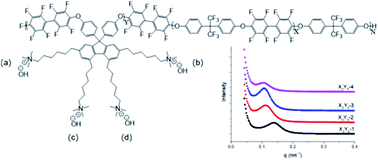Anion conducting multiblock copolymers with multiple head-groups
Abstract
Multiblock copoly(arylene ether)s with 1, 2, 3 and 4 alkyl chain tethered quaternary ammonium head-groups on each hydrophilic repeat unit were synthesized via polycondensation, Friedel–Crafts, and reduction reactions. The effect of the number of ionic groups on the ion exchange capacity (IEC), morphology and properties of the anion exchange membranes was investigated. As the ionic group density increased, both the ionic conductivity and water uptake of the membranes increased. The 3-tether membrane formed the most efficient ionic channels as determined by the highest ionic conductivity/IEC. The 2, 3, and 4-tether (per hydrophilic repeat unit) membranes had 9 to 10 bound waters of hydration per ionic group pair, however, the amount of unbound, freezable water molecules increased with the number of ion pairs per polymer repeat unit. The unbound, freezable water molecule was unproductive and led to lower ionic conductivity/IEC ratio, such as in the 4-tether membrane. The optimal membrane had three head-groups per hydrophilic repeat unit (X3Y5-3): 130.6 mS cm−1 ionic conductivity at 80 °C, 58.3% water uptake, and an IEC of 1.83 meq g−1. All the membranes showed acceptable thermal stability and alkaline stability in 1 M KOH at 60 °C for 1000 h. As the number of head-groups per hydrophilic repeat unit increased, the mechanical strength of the membranes decreased.

- This article is part of the themed collection: Materials and Nano Research in Atlanta

 Please wait while we load your content...
Please wait while we load your content...
